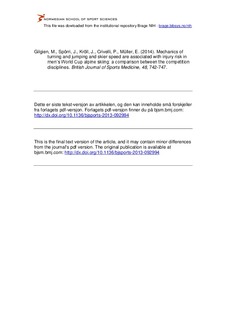| dc.contributor.author | Gilgien, Matthias | |
| dc.contributor.author | Spörri, Jörg | |
| dc.contributor.author | Kröll, Josef | |
| dc.contributor.author | Crivelli, Philip | |
| dc.contributor.author | Müller, Erich | |
| dc.date.accessioned | 2014-09-03T12:25:26Z | |
| dc.date.available | 2014-09-03T12:25:26Z | |
| dc.date.issued | 2014-01-31 | |
| dc.identifier.citation | British Journal of Sports Medicine. 2014, 48, 742-747 | nb_NO |
| dc.identifier.uri | http://hdl.handle.net/11250/218691 | |
| dc.description | I Brage finner du siste tekst-versjon av artikkelen, og den kan inneholde ubetydelige forskjeller fra forlagets pdf-versjon. Forlagets pdf-versjon finner du på www.sciencedirect.com: bjsm.bmj.com: http://dx.doi.org/10.1136/bjsports-2013-092994 / In Brage you'll find the final text version of the article, and it may contain insignificant differences from the journal's pdf version. The original publication is available at bjsm.bmj.com: http://dx.doi.org/10.1136/bjsports-2013-092994 | nb_NO |
| dc.description.abstract | Background/aim: In alpine ski racing, there is limited information about skiers’ mechanical characteristics and their relation to injury risk, in particular for World Cup (WC) competitions. Hence, current findings from epidemiological and qualitative research cannot be linked to skiers’ mechanics. This study was undertaken to investigate whether recently reported differences in numbers of injuries per 1000 runs for competition disciplines can be explained by differences in the skiers’ mechanics.
Methods: During seven giant slalom, four super-G and five downhill WC competitions, mechanical characteristics of a forerunner were captured using differential global navigation satellite technology and a precise terrain surface model. Finally, the discipline-specific skiers’ mechanics were compared with the respective number of injuries per hour skiing.
Results: While the number of injuries per hour skiing was approximately equal for all disciplines, kinetic energy, impulse, run time, turn radius and turn speed were significantly different and increased from giant slalom to super-G and downhill. Turn ground reaction forces were largest for giant slalom, followed by super-G and downhill. The number of jumps was doubled from super-G to downhill.
Conclusions: Associating the number of injuries per hour in WC skiing with skiers’ mechanical characteristics, injuries in super-G and downhill seem to be related to increased speed and jumps, while injuries in giant slalom may be related to high loads in turning. The reported differences in the number of injuries per 1000 runs might be explained by a bias in total exposure time per run and thus potentially by emerged fatigue. | nb_NO |
| dc.language.iso | eng | nb_NO |
| dc.publisher | BMJ Publishing Group | nb_NO |
| dc.title | Mechanics of turning and jumping and skier speed are associated with injury risk in men's World Cup alpine skiing: a comparison between the competition disciplines | nb_NO |
| dc.type | Journal article | nb_NO |
| dc.type | Peer reviewed | nb_NO |
| dc.subject.nsi | VDP::Social science: 200::Social science in sports: 330::Other subjects within physical education: 339 | nb_NO |
| dc.source.journal | British Journal of Sports Medicine | nb_NO |
| dc.description.localcode | Seksjon for fysisk prestasjonsevne / Department of Physical Performance | nb_NO |
